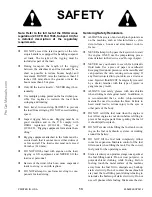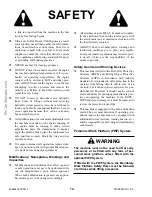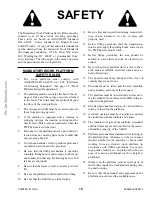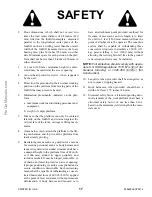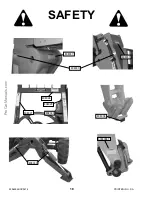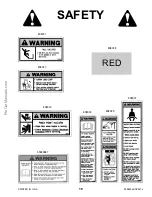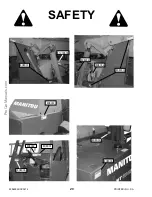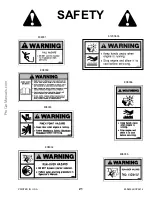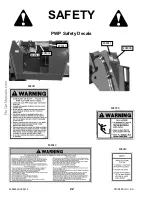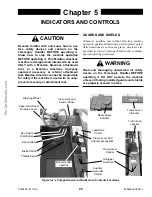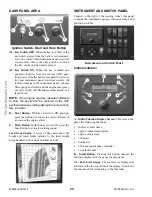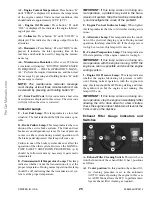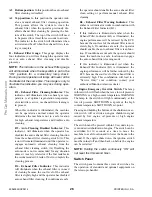
PRINTED IN U.S.A.
11
50960025/CP0514
the rear before backing.
Ü
DO NOT raise or drop a loaded fork or bucket
suddenly. Abrupt movements under load can
cause serious instability.
Ü
Study the load chart carefully. It shows maximum
capacity to be lifted and placed at specific out-
ward and upward distances. ALWAYS be aware
of load weights prior to attempting lift and place-
ment with this machine.
Ü
DO NOT exceed the machine’s rated operating
capacity for the type of attachment tool being
used.
Ü
DO NOT use outriggers on soft or uneven sur-
faces.
BE SURE
the surface can support the
machine and load.
Ü
DO NOT allow minors or any unqualified per-
sonnel to operate or be near the machine unless
properly supervised.
Ü
DO NOT start the engine or operate any controls
unless properly seated in the operator’s seat!
Ü
DO NOT run the engine in an enclosed area with-
out providing proper ventilation for the exhaust.
Exhaust gases contain carbon monoxide, an odor-
less and deadly gas. Internal combustion engines
deplete the oxygen supply within enclosed spaces
and may create a serious hazard unless the oxygen
is replaced. This includes the atmosphere within
the cab when equipped.
Ü
DO NOT leave the operator’s station with the
boom and attachment tool raised. ALWAYS
lower the boom and attachment tool to the
ground, shut off the engine and engage the park-
ing brake before leaving the operator’s station.
Ü
NEVER travel with the boom above the carry
position (attachment tool should be at minimum
ground clearance.) Boom should be fully retract-
ed.
Ü
DO NOT drive too close to an excavation or
ditch. BE SURE that the surrounding ground has
adequate strength to support the weight of the
machine and the load it is carrying.
Ü
ALWAYS wear appropriate personal protective
equipment for the job and working conditions.
Hard hats, goggles, protective shoes, gloves,
reflector-type vests, respirators and ear protection
are exampes of types of equipment that may be
required. DO NOT wear loose fitting clothing,
long hair, jewelry or loose personal items while
operating or servicing the machine.
Ü
ALWAYS check the job site for terrain hazards,
obstructions and people. Remove all objects that
do not belong in or on the machine and its equip-
ment.
Operation Safety Reminders
Ü
Any or all of the following elements may affect
the stability of the machine: terrain, engine speed,
type of load being carried and placed, improper
tire inflation, weight of the attachment tool, and
abrupt movement of any control lever.
IF YOU
ARE NOT CAREFUL WHILE OPERATING
THIS MACHINE, ANY OF THE ABOVE
FACTORS COULD CAUSE THE MACHINE
TO TIP AND THROW YOU OUT OF THE
OPERATOR’S STATION, WHICH MAY
CAUSE SERIOUS BODILY INJURY OR
DEATH!
Ü
ALWAYS wear the seat belt provided to prevent
being thrown from the machine. If you are in an
overturn:
- DO NOT jump!
- Hold on tight and stay with the machine!
- Lean away from the fall!
Ü
ALWAYS keep hands, feet and arms inside of the
operator’s station when operating the machine!
Ü
ALWAYS use the recommended hand holds and
steps with at least three points of support when
getting on and off the machine. Keep steps and
platform clean. Face the machine when climbing
up and down.
Ü
DO NOT depend on the backup alarm to clear
bystanders out of the path of the machine.
ALWAYS look in the direction of travel. Look to
SAFETY

















